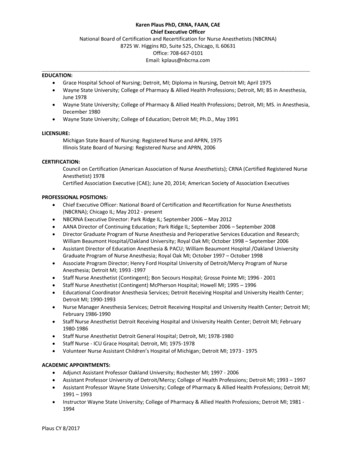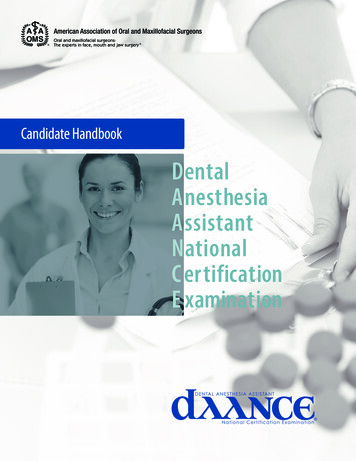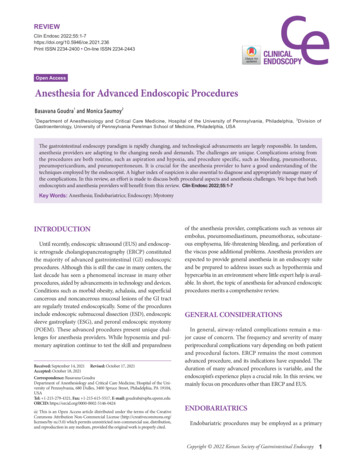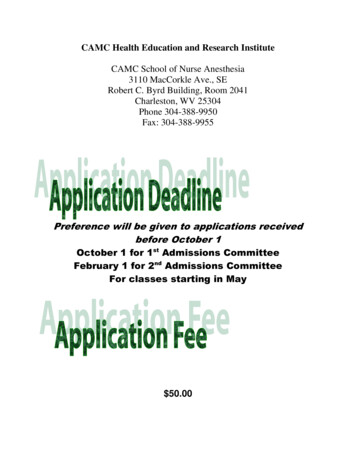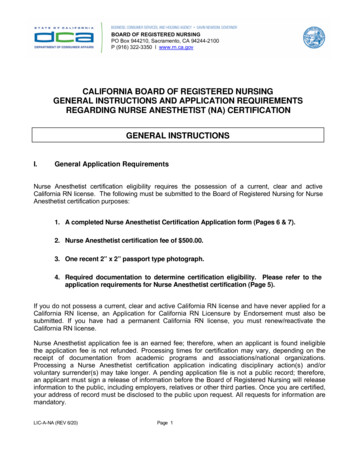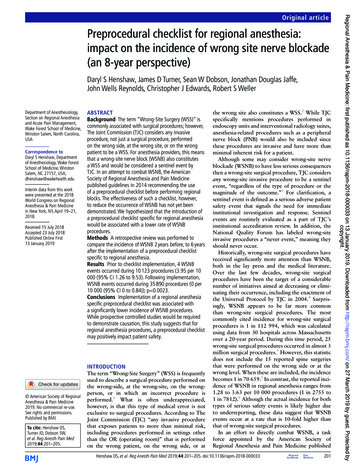
Transcription
Preprocedural checklist for regional anesthesia:impact on the incidence of wrong site nerve blockade(an 8-year perspective)Daryl S Henshaw, James D Turner, Sean W Dobson, Jonathan Douglas Jaffe,John Wells Reynolds, Christopher J Edwards, Robert S WellerDepartment of Anesthesiology,Section on Regional Anesthesiaand Acute Pain Management,Wake Forest School of Medicine,Winston Salem, North Carolina,USACorrespondence toDaryl S Henshaw, Departmentof Anesthesiology, Wake ForestSchool of Medicine, WinstonSalem, NC 27157, USA;dhenshaw@wakehealth.eduInterim data from this workwere presented at the 2018World Congress on RegionalAnesthesia & Pain Medicinein New York, NY, April 19–21,2018.Received 15 July 2018Accepted 23 July 2018Published Online First13 January 2019ABSTRACTBackground The term “Wrong-Site Surgery (WSS)” iscommonly associated with surgical procedures; however,The Joint Commission (TJC) considers any invasiveprocedure, not just a surgical procedure, performedon the wrong side, at the wrong site, or on the wrongpatient to be a WSS. For anesthesia providers, this meansthat a wrong-site nerve block (WSNB) also constitutesa WSS and would be considered a sentinel event byTJC. In an attempt to combat WSNB, the AmericanSociety of Regional Anesthesia and Pain Medicinepublished guidelines in 2014 recommending the useof a preprocedural checklist before performing regionalblocks. The effectiveness of such a checklist, however,to reduce the occurrence of WSNB has not yet beendemonstrated. We hypothesized that the introduction ofa preprocedural checklist specific for regional anesthesiawould be associated with a lower rate of WSNBprocedures.Methods A retrospective review was performed tocompare the incidence of WSNB 2 years before, to 6 yearsafter the implementation of a preprocedural checklistspecific to regional anesthesia.Results Prior to checklist implementation, 4 WSNBevents occurred during 10 123 procedures (3.95 per 10000 (95% CI 1.26 to 9.53). Following implementation,WSNB events occurred during 35 890 procedures (0 per10 000 (95% CI 0 to 0.84)); p 0.0023.Conclusions Implementation of a regional anesthesiaspecific preprocedural checklist was associated witha significantly lower incidence of WSNB procedures.While prospective controlled studies would be requiredto demonstrate causation, this study suggests that forregional anesthesia procedures, a preprocedural checklistmay positively impact patient safety.INTRODUCTION American Society of RegionalAnesthesia & Pain Medicine2019. No commercial re-use.See rights and permissions.Published by BMJ.To cite: Henshaw DS,Turner JD, Dobson SW,et al. Reg Anesth Pain Med2019;44:201–205.The term “Wrong-Site Surgery” (WSS) is frequentlyused to describe a surgical procedure performed onthe wrong-side, at the wrong-site, on the wrongperson, or in which an incorrect procedure isperformed.1 What is often underappreciated,however, is that this type of medical error is notexclusive to surgical procedures. According to TheJoint Commission (TJC) “any invasive procedurethat exposes patients to more than minimal risk,including procedures performed in settings otherthan the OR (operating room)” that is performedon the wrong patient, on the wrong side, or atthe wrong site also constitutes a WSS.2 While TJCspecifically mentions procedures performed inendoscopy units and interventional radiology suites,anesthesia-related procedures such as a peripheralnerve block (PNB) would also be included sincethese procedures are invasive and have more thanminimal inherent risk for a patient.Although some may consider wrong-site nerveblockade (WSNB) to have less serious consequencesthen a wrong-site surgical procedure, TJC considersany wrong-site invasive procedure to be a sentinelevent, “regardless of the type of procedure or themagnitude of the outcome.”3 For clarification, asentinel event is defined as a serious adverse patientsafety event that signals the need for immediateinstitutional investigation and response. Sentinelevents are routinely evaluated as a part of TJC’sinstitutional accreditation review. In addition, theNational Quality Forum has labeled wrong-siteinvasive procedures a “never event,” meaning theyshould never occur.Historically, wrong-site surgical procedures havereceived significantly more attention than WSNB,both in the lay press and the medical literature.Over the last few decades, wrong-site surgicalprocedures have been the target of a considerablenumber of initiatives aimed at decreasing or eliminating their occurrence, including the enactment ofthe Universal Protocol by TJC in 2004.4 Surprisingly, WSNB appears to be far more commonthan wrong-site surgical procedures. The mostcommonly cited incidence for wrong-site surgicalprocedures is 1 in 112 994, which was calculatedusing data from 30 hospitals across Massachusettsover a 20-year period. During this time period, 25wrong-site surgical procedures occurred in almost 3million surgical procedures.5 However, this statisticdoes not include the 15 reported spine surgeriesthat were performed on the wrong side or at thewrong level. When these are included, the incidencebecomes 1 in 70 659.5 In contrast, the reported incidence of WSNB in regional anesthesia ranges from1.28 to 3.63 per 10 000 procedures (1 in 2755 to1 in 7812).6 Although the actual incidence for bothtypes of serious safety events is likely higher dueto underreporting, these data suggest that WSNBevents occur at a rate that is 10-fold higher thanthat of wrong-site surgical procedures.In an effort to directly combat WSNB, a taskforce appointed by the American Society ofRegional Anesthesia and Pain Medicine publishedHenshaw DS, et al. Reg Anesth Pain Med 2019;44:201–205. doi:10.1136/rapm-2018-000033201Regional Anesthesia & Pain Medicine: first published as 10.1136/rapm-2018-000033 on 13 January 2019. Downloaded from http://rapm.bmj.com/ on 27 March 2019 by guest. Protected bycopyright.Original article
recommendations in 2014 regarding a preprocedural checklistspecific to regional anesthesia.7 While the use of a checklist priorto surgical procedures has been shown to significantly influencevarious surgical outcomes including mortality,8 the utility of apreprocedural checklist for decreasing the rate of WSNB has notbeen established.9The aim of this study was to investigate the impact that apreprocedural regional anesthesia-specific checklist may have onthe rate of WSNB by directly comparing the incidence of WSNBevents occurring both before and after implementation. Thehypothesis, defined a priori, was that the incidence of WSNBwould be significantly lower following checklist implementation.METHODSInstitutional review board (IRB) approval was obtained prior tostudy initiation and the need for informed consent was formallywaived (Wake Forest University Health Sciences, #00048477,02/15/2018). The study period of interest ran from July 1,2009 to June 30, 2017 (fiscal years 2010–2017, with a fiscalyear defined as July 1–June 30). The study was conductedacross two sister institutions, both under the umbrella of WakeForest Baptist Health in Winston Salem, North Carolina, USA.These included a tertiary care hospital, level-one trauma centerand academic training facility (Wake Forest Baptist MedicalCenter) and a predominantly outpatient surgical center (DavieMedical Center), where total joint replacement surgeries are alsoperformed, which opened during fiscal year 2014.The primary outcome was the incidence of WSNB, calculatedper 10 000 regional anesthesia PNB procedures, occurring bothprior to a specific intervention and afterwards. The interventionof interest, which occurred on July 1, 2011, was the implementation of a preprocedural checklist to be performed prior to allregional anesthesia procedures (figure 1). For purposes of thestudy, this date delineated the preintervention group (fiscal years2010–2011 from the postintervention group (fiscal years 2012–2017. All PNB procedures performed during the time-period ofinterest were included in the analysis, regardless of whether theywere performed for analgesia or anesthesia. However, neuraxialprocedures (both epidural and subarachnoid procedures) werenot included.The rates of WSNB in the preintervention and postintervention groups were compared using a Fisher’s exact test and 95%CI were subsequently determined. Data analysis was performedusing SAS, V.9.4 (SAS Institute, Cary, North Carolina, USA).The number of WSNB procedures that occurred per fiscalyear (numerator) over the study period was determined throughquery of institutionally maintained safety databases, which areused to categorize and track adverse events. From the start ofthe study period (fiscal year 2010) through September of 2011,the institutional database used for adverse event reporting wasPatient Safety Net (University Health System Consortium).Starting in October 2011 and continuing through the end of thestudy period, RL solutions was used. While these databases wereaccessed retrospectively, the filing of safety events occurred inreal-time by front-line providers involved in the adverse event,and each patient safety event was both recorded and investigatedat the time of its occurrence.The number of nerve block procedures performed per fiscalyear (denominator) encompassed PNBs performed for eithersurgical anesthesia or for postoperative analgesia. Paravertebraland truncal blocks were included, but neuraxial blocks (subarachnoid and epidural) were excluded. Both billing codes and procedural documentation in the electronic health record (EHR) were202used, but because conversion to a new EHR occurred during thestudy period, some assumptions and estimates related to annualblock totals for some years were required, as described below.For fiscal years 2014–2017, the total number of nerve blockprocedures performed annually, both those intended for analgesia and for surgical anesthesia, were calculated through a queryof the current EHR (Epic; Epic Systems, Verona, Wisconsin,USA). In addition, this time period was used to calculate theratio of blocks performed for analgesia to blocks performedfor anesthesia. Because the prior EHR used during fiscal years2010–2012, was no longer accessible for data mining, billingrecords were used to determine the annual number of CurrentProcedural Terminology (CPT) codes, specific to PNB procedures, submitted annually during this time period. Since blocksfor surgical anesthesia could not be captured from billing datafor 2010–2012 (anesthetic blocks are billed by time-units ratherthan CPT code), the total annual block numbers during theseyears were estimated by applying the analgesic to anestheticnerve block ratio calculated from the 2014–2017 dataset. TheEHR transition occurred during fiscal year 2013, resulting inbilling and data lapses that prevented an accurate determination of the number of nerve block procedures performed duringthis fiscal year. The number of nerve block procedures for 2013was then estimated as the average of nerve block proceduresperformed during fiscal years 2012 and 2014.RESULTSBoth the total number of nerve block procedures performedannually and the annual incidence of WSNB occurring from2010 to 2017 are depicted in figure 2. The ratio of analgesic toanesthetic nerve block procedures performed during fiscal years2014–2017 was 3.61 to 1.In the 2-year period prior to the intervention (fiscal years2010 and 2011), a total of 10 123 nerve blocks were performed.Over this same time period, four WSNB procedures occurred,resulting in a calculated incidence of WSNB of 3.95 per 10 000procedures (95% CI 1.26 to 9.53).In the 6-year period following the implementation of thepreprocedural checklist specific to regional anesthesia procedures 2012–2017, a total of 35 890 nerve blocks were performed.During this time period, a total of zero WSNB occurred, resultingin a calculated incidence for WSNB of 0 per 10 000 procedures(95% CI 0 to 0.84).The preintervention and postintervention rates of WSNBwere significantly different with p value of 0.0023.DISCUSSIONDespite the amount of attention that WSS has received over thelast two decades, the breadth of previously published literature/research on the subject of WSNB is surprisingly limited. Whilethere have been a few reports that have quantified the overallincidence of WSNB in regional anesthesia,6 9 and an extensivereview article on WSNB that included recommendations forpotential prevention,6 only the study by Hudson and colleaguesinvestigated the potential impact that a checklist or timeoutpolicy could have on the incidence of WSNB.10 In their study,the authors reported a pre-timeout WSNB incidence of 1.39 per10 000 procedures compared with a post-timeout WSNB incidence of 0.7 per 10 000 procedures. Although the frequency ofWSNB procedures in this study did appear to decrease after aninstitutional timeout was enacted, the authors stated that “therewas no association between the number of wrong-site blocks andthe existence of the (timeout) policy.” Based on their statement,Henshaw DS, et al. Reg Anesth Pain Med 2019;44:201–205. doi:10.1136/rapm-2018-000033Regional Anesthesia & Pain Medicine: first published as 10.1136/rapm-2018-000033 on 13 January 2019. Downloaded from http://rapm.bmj.com/ on 27 March 2019 by guest. Protected bycopyright.Original article
Figure 1 Our organization’s regional anesthesia Pre-Procedural Timeout checklist.it must be assumed that there was not a statistical differencebetween the preintervention and postintervention incidences ofWSNB, although no p value was given.In contrast, our study was able to demonstrate an associationbetween the existence of a preprocedural checklist for regionalanesthesia and a lower incidence of WSNB. One potential reasonwhy our results differ from prior studies might be related tochecklist compliance. Previously, it has been suggested that theimplementation of a checklist, by itself, might not be enoughto prevent medical errors.11 In order to be most effective andprevent patient safety errors, a checklist needs to be implementedand it must be used both consistently and completely.4 Thisstatement is supported by the results of Hudson and colleagues,where two of the three WSNB procedures that occurred after theHenshaw DS, et al. Reg Anesth Pain Med 2019;44:201–205. doi:10.1136/rapm-2018-000033203Regional Anesthesia & Pain Medicine: first published as 10.1136/rapm-2018-000033 on 13 January 2019. Downloaded from http://rapm.bmj.com/ on 27 March 2019 by guest. Protected bycopyright.Original article
Figure 2 Graphic representation of preintervention and postintervention annual numbers of peripheral nerve blocks and the number of wrong-sidenerve blocks occurring annually.implementation of their timeout process were attributed to omissions or deviations from their established processes.10 Had therebeen checklist adherence, it is likely that these adverse eventswould have been prevented, and it is possible that the authorswould have then been able to find an association between thepresence of a checklist and WSNB procedures.Although determining checklist compliance over our studyperiod was not possible due to EHR transition, it is importantto note that any retrospective method of quantifying checklistcompliance is unlikely to reflect true checklist fidelity. In a priorprospective study of 142 surgical procedures, the “documented”compliance rate for the use of a surgical checklist was 100%.However, an observer auditing the thoroughness of the checklist process found that none of the cases actually executed allthe items on the checklist.12 Inconsistencies in using a checklist/timeout also appear to be a key reason why cases of WSS,including WSNB, continue to occur. In 2017, 36 WSS eventswere reported in the state of Minnesota, which is one of severalstates that mandate reporting of adverse events.13 This was thehighest annual number of events reported over the last 10 years,and it is notable that spinal injections and preprocedural injections were the most common type of WSS.13 Root cause analysesof these adverse events found that site marking was omitted 41%of the time, site marking (when done) was not visually confirmed11% of the time, and source documentation was not referencedduring the timeout 19% of the time.A second potential reason why our study found a positiveassociation, when other studies could not, is more complex andless tangible and that is culture. It must be noted that at the studyinstitution, implementation of the regional anesthesia checklist was part of a much broader initiative to incorporate crewresource management techniques and tools throughout the institution’s operating rooms. Multiple other checklists as well asstandardized processes for both patient hand-offs and communication were introduced concurrently. In addition, all surgicalservices employees (1600 individuals) received structuredteamwork-based training that emphasized the need to shareinformation openly, to speak up if/when they observe somethingthat is not in the patient’s best interest, to consistently use the204patient safety tools, and the importance of creating/maintaininga culture of safety. This training has continued to be provided ona monthly basis for all new employees.Creating a culture of safety is of significant importance as itnot only helps to ensure that the checklist is used consistentlyand correctly, it also helps to foster a shared sense of mission sothat providers hold each other accountable and work toward thecommon goal of patient safety. In fact, culture has been recognized as being equally as important as the actual checklist to thesuccess of the landmark Keystone intensive care unit project inwhich catheter-related blood stream infections were significantlyreduced after implementation of a checklist.14In regards to the preprocedural checklist and processes in placeat our institution there are a few things that warrant further elaboration. First, regional anesthesia procedures can be performedprior to surgical site making as long as the laterality and procedure specified on the surgical consent matches the details of thecase posting in the EHR as well as the patient’s stated expectations. For this reason, our checklist does not call for verificationof surgical site marking prior to nerve blockade. However, ifthere are any discrepancies between the consent, case posting,or patient expectations, these must be rectified by the surgicalteam prior to proceeding. Second, it should be noted thatdirectly involving the patient in the timeout process is viewed asa critically important step, as demonstrated by the requirementthat they state their name, date of birth, procedure, and side atthe beginning of the timeout process. For non-English speakingpatients, an interpreter is routinely used to accomplish this taskand these are available both in-hours and remotely by videoconference 24 hours a day. For cognitively impaired patients orpediatric patients, the legal guardian is allowed to assume therole of the patient and to verify the required information.This study has a number of limitations that warrant discussion. First, the retrospective design of the study introduces thepotential for confounding, and it is, therefore, not possible todetermine causality between the presence of the checklist anda lower rate of WSNB procedures. While a prospective studywould do so, performing such a study would likely be extremelydifficult, if not impossible, given the rarity with which WSNBHenshaw DS, et al. Reg Anesth Pain Med 2019;44:201–205. doi:10.1136/rapm-2018-000033Regional Anesthesia & Pain Medicine: first published as 10.1136/rapm-2018-000033 on 13 January 2019. Downloaded from http://rapm.bmj.com/ on 27 March 2019 by guest. Protected bycopyright.Original article
procedures occur. In addition, randomizing patients to a studyarm in which a checklist of some sort is not used would likelybe seen as unsafe/unethical given TJC’s requirements and theUniversal Protocol.Second, some assumptions were required to calculate annualblock totals. It was assumed that regional anesthesia volumeand the ratio of analgesic to anesthetic nerve blocks were relatively consistent across years, and it should be recognized thatthe number of nerve block procedures for years 2010 through2013 are, therefore, best approximations. However, given thelarge difference in WSNB incidence between the preinterventionand postintervention time periods in this study, as well as thelarge sample size, it is unlikely that estimating block totals forthese fiscal years significantly affected the outcome. In addition,regardless of the method used to calculate block totals, the retrospective nature of the study would have introduced the potentialthat not all block data would be appropriately identified.Third, it is possible that not all WSNB events occurring duringthe study period were captured. While events could have beenmissed during data collection, in general, serious patient safetyevents like WSNB procedures are captured in real time andtrigger an extensive investigation to determine their root cause,design an action plan, and to implement process change. Thisrobust incident review process makes it highly unlikely that anyevents were missed during data collection. However, given theperceived stigma of being involved in this, or any other kind, ofserious patient safety event, it is conceivable that events occurred(both in the preintervention and postintervention time periods)and were not reported.It is also important to note that it was not feasible to capturenear miss WSNB events in this study. Certainly one of the potential mechanisms by which a preprocedural checklist may preventWSNB events from occurring is by identifying and stoppingerrors before harm reaches the patient. While it would have beeninteresting to explore the association between the presence ofthe checklist and the rate of near miss events, this was unfortunately not possible given the study design.Finally, during data analysis, we chose to include all PNBsand to exclude neuraxial procedures. Although some previousstudies have elected to exclude bilateral blocks, under theassumption that they are unlikely to be performed on the wrongside, we chose to include them as it is still possible that bilateral blockade could be performed on the wrong patient or thatthe wrong block(s) could be performed. On the other hand, weelected to not include neuraxial blocks (spinals and epidurals)in the analysis. While the same argument could be made forneuraxial procedures, the scope of this study was peripheralnerve blockade.Of note, all four WSNB procedures that occurred in the preintervention period were PNBs performed on the wrong side. Twoof the events in fiscal year 2011, a combined femoral catheterand single-injection sciatic nerve block performed for a totalknee arthroplasty and an ankle block performed for an incisionand drainage of a foot wound, occurred despite a timeout beingperformed. The ankle block patient had wounds on both feet,which potentially contributed to the error. However, in bothinstances, the attending anesthesiologist was not present for thetimeout. In the third event during fiscal year 2011, no timeoutwas performed prior to the procedure. While the safety databasequery revealed that a WSNB occurred in April of 2010, additional details surrounding the event, other than it occurred onthe wrong side, were not available.In conclusion, the implementation of a preprocedural regionalanesthesia-specific checklist at our institution was associatedwith a significant reduction in the rate of wrong side nerve blockprocedures and should be strongly considered as a key component of creating a culture of safety aimed at improving patientsafety and reducing serious safety events.Competing interests None declared.Ethics approval Institutional review board (IRB) approval was obtained prior tostudy initiation and the need for informed consent was formally waived (Wake ForestUniversity Health Sciences, # 00048477)REFERENCES1 Fraser SG, Adams W. Wrong site surgery. Br J Ophthalmol 2006;90:814–6.2 Mulloy DF, Hughes RG. Wrong-site surgery: A preventable error. In: Hughes RG, ed.Patient Safety and Quality: An Evidence-Based Handbook for Nurses. Rockville, MD:Agency for Healthcare Research and Quality (AHRQ), 2008: 1–11.3 The Joint Commission. Sentinel Events. Comprehensive Accreditation Manual forHospitals, Update 1. 2017. Available: https://www.jointcommission.org/assets/1/6/CAMH SE 0717.pdf [Accessed 20 Apr 2018].4 Treadwell JR, Lucas S, Tsou AY. Surgical checklists: a systematic review of impacts andimplementation. BMJ Qual Saf 2014;23:299–318.5 Kwaan MR, Studdert DM, Zinner MJ, et al. Incidence, patterns, and prevention ofwrong-site surgery. Arch Surg 2006;141:353–7.6 Barrington MJ, Uda Y, Pattullo SJ, et al. Wrong-site regional anesthesia: review andrecommendations for prevention? Curr Opin Anaesthesiol 2015;28:670–84.7 Mulroy MF, Weller RS, Liguori GA. A checklist for performing regional nerve blocks.Reg Anesth Pain Med 2014;39:195–9.8 Haynes AB, Weiser TG, Berry WR, et al. A surgical safety checklist to reduce morbidityand mortality in a global population. N Engl J Med 2009;360:491–9.9 Sites BD, Barrington MJ, Davis M. Using an international clinical registry of regionalanesthesia to identify targets for quality improvement. Reg Anesth Pain Med2014;39:487–95.10 Hudson ME, Chelly JE, Lichter JR. Wrong-site nerve blocks: 10 yr experience in a largemultihospital health-care system. Br J Anaesth 2015;114:818–24.11 Urbach DR, Govindarajan A, Saskin R, et al. Introduction of surgical safety checklistsin Ontario, Canada. N Engl J Med 2014;370:1029–38.12 Levy SM, Senter CE, Hawkins RB, et al. Implementing a surgical checklist: more thanchecking a box. Surgery 2012;152:331–6.13 Adverse Health Events in Minnesota, 14th Annual Public Report. 2018. ety/ae/2018ahereport.pdf [Accessed 16 May2018].14 Bosk CL, Dixon-Woods M, Goeschel CA, et al. Reality check for checklists. Lancet2009;374:444–5.Henshaw DS, et al. Reg Anesth Pain Med 2019;44:201–205. doi:10.1136/rapm-2018-000033205Regional Anesthesia & Pain Medicine: first published as 10.1136/rapm-2018-000033 on 13 January 2019. Downloaded from http://rapm.bmj.com/ on 27 March 2019 by guest. Protected bycopyright.Original article
Preprocedural checklist for regional anesthesia: impact on the incidence of wrong site nerve blockade (an 8-year perspective) Daryl S Henshaw, James D Turner, Sean W Dobson, Jonathan Douglas Jaffe, John Wells Reynolds, Christopher J Edwards, Robert S Weller To cite: Henshaw DS, Turner J
